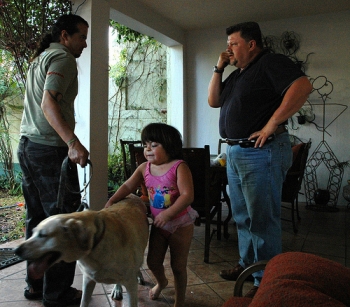Treating Anxiety in Children with Cognitive Behavioral Therapy (CBT)

Everyone experiences anxiety at one point in their lives. In fact, anxiety can even protect and help us. Just the right amount of anxiety keeps us focused and working hard when taking a test, and keeps us away from obvious dangers. But when we experience high levels of anxiety, we view nonthreatening events as dangerous, and that fear can make life more difficult.
All children experience some anxiety, which can be developmentally appropriate. We have all heard of childhood fears, such as being afraid of the dark, the boogieman and separating from parents on the first day of school. Many children have specific fears, and worry about school performance, health and social concerns (Muris, Meesters, Merckelbach, Sermon, & Zwakhalen, 1998; Vasey, Crnic, & Carter, 1994). For approximately 15-20% of all children, these anxieties, fears and worries are intense, interfere with everyday functioning and meet diagnostic criteria for anxiety disorders (Beesdo, Knappe, & Pine, 2011). The effects of anxious symptoms on children are potentially debilitating if left untreated and are associated with poor academic performance, social problems and sleep disturbances in childhood (Alfano, Ginsburg, Kingery, & Newman, 2007; Wood, 2006). For some, the course continues into adolescence with a possibility of comorbid psychological disturbance and substance abuse (Woodward & Fergusson, 2001).
But there is hope: anxiety is treatable.
A typical anxiety case would go something like this: John, an 8-year-old boy who previously played soccer had many friends and achieved straight A’s. However, he began to withdraw from activities that he loved. He began to worry about separating from his parents for fear that something would happen to him or them. He had trouble sleeping in his own bed, sleeping over his cousin’s house and spending time with friends. He complained of headaches and stomachaches on days that he would have to separate from his parents. Suddenly, things he used to look forward to, such as going to school or soccer practice, would be extremely difficult and often result in him crying and begging his parents to let him stay with them. Once he eventually separated from his parents, it would not be long before his parents would receive numerous calls from him seeking reassurance.
John’s parents took him to his pediatrician who explained that there was no physical cause for his stomachaches and headaches and that he was experiencing Separation Anxiety Disorder and recommended a course of Cognitive Behavioral Therapy (CBT).
CBT is considered to be a highly effective treatment for anxiety in children (Butler, Chapman, Foreman, Beck, 2006). The concept behind CBT is that thoughts, emotions and behaviors are all related to each other. Specifically, cognitions influence emotions and behaviors. CBT is an active therapy with interventions and specific goals where children and their parents learn active coping tools to manage symptoms.
John and his parents made an appointment with a psychologist who specialized in CBT. After a thorough developmental history and evaluation, the psychologist agreed that John had a diagnosis of Separation Anxiety Disorder. The psychologist worked with John and his parents. John learned how to cope with anxiety and his parents learned how to coach him through anxiety provoking situations. They were taught diaphragmatic breathing, progressive muscle relaxation, how to identify automatic thoughts, how to change negative thoughts into coping statements, and how to slowly and systematically face feared situations. Soon John was back to his old self, enjoying his life, playing soccer, sleeping over his cousin’s house, and going to school.
If you suspect that your child has an anxiety disorder, it is important to seek an evaluation from a mental health professional that specializes in children and is trained in CBT. The use of CBT to treat children with anxiety disorders has been supported in the literature. After a 16-week protocol, children with anxiety disorder given CBT had significantly less anxiety than the wait list control. The children who received CBT no longer met the diagnostic criteria for an anxiety disorder and maintained that through a one year follow up. These same results have been replicated in others studies (Kendall, Flannery-Schroeder, Panichelli-Mindel, Southam-Gerow, Henin & Warman, 1997). Similarly, Flannery-Schroeder & Kendall (2000) randomly assigned children to treatment groups and found that 75% of individually treated children no longer met diagnostic criteria and maintained treatment gains at their 3-month follow up.
Every child is different and 16 weeks will not necessarily be enough time, especially if the child experiences more than one anxiety disorder. However, CBT can provide the child and parents with tools to actively cope with life stressors and anxiety.
